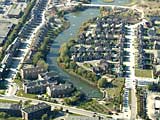2
Encourage the construction of 60,000 to 75,000 housing units between 2004 and 2014
Guided by the principles of sustainable development, the City intends to promote the consolidation of development within its territory while fully respecting existing urban and architectural characteristics.
 This is a major challenge, because residential growth over the past few decades has mainly taken place on the outskirts of Montréal. In fact, Montréal, which accounts for approximately 53% of the population of the metropolitan area (CMA), attracted an average of only 27% of new households between 1991 and 2001.
This is a major challenge, because residential growth over the past few decades has mainly taken place on the outskirts of Montréal. In fact, Montréal, which accounts for approximately 53% of the population of the metropolitan area (CMA), attracted an average of only 27% of new households between 1991 and 2001.
It is estimated that the number of households in the Montréal CMA will increase by 150,000 during the 2004-2014 period. The City sets an ambitious but realistic objective of supporting the construction of 60,000 to 75,000 new housing units, which would accommodate 40% to 50% of these 150,000 new households. Between 1984 and 2003, Montréal's share of the region's total new housing construction varied between 22% and 34%. In light of this, the City will have to make major efforts in order to achieve its new objective.
Montréal's territory holds the potential for an estimated 130,000 new dwellings, located in vacant lots, sites to be transformed, or in non-residential buildings which can be converted. Vacant lots cover a total area of 13 km2, for a potential 55,000 new dwellings. Sites suitable for residential redevelopment would permit the construction of another 55,000 dwellings. Finally, buildings currently used for industrial, commercial or institutional purposes represent the potential for some 20,000 new dwellings, located in areas already well served by public infrastructure and often in proximity to public transit.
A large portion of this potential growth, approximately 15,000 housing units, is located in Montréal's Centre, well served with transportation infrastructure, stores and facilities as well as excellent public transit (see Objective 6). The West Island and the north-central portion of the City also account for a large share of the residential potential.